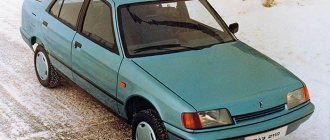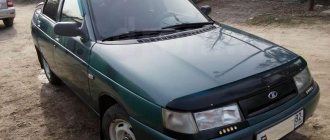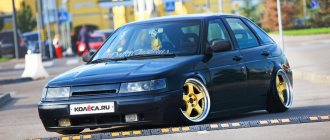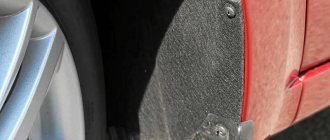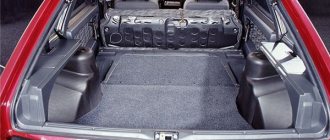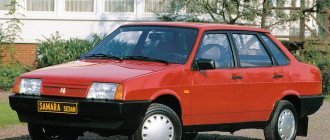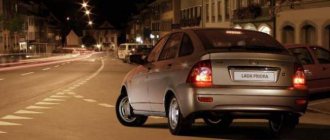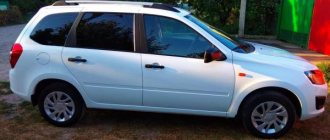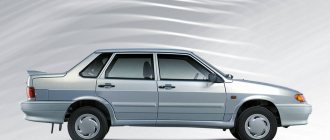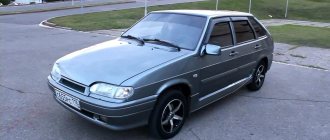The VAZ 2110 car was produced from 1995 to 2007. This sedan was created on the basis of the Lada 2108 hatchback. The dimensions of the VAZ 2110 differ slightly from the overall dimensions of the 21099 model. In particular, the length of the VAZ 2110 is only 6 cm longer than the length of the only sedan from the Lada Samara model range.
The length of the wheelbase is 3.2 cm longer, the height of the car is 1.8 cm, and the ground clearance of the loaded “ten” is 5 cm higher than that of the ninety-ninth. The front and rear wheel tracks of these sedans are the same. The same engines and gearboxes were installed on both cars.
However, despite all this, the technical characteristics of cars 2110 and 21099 are somewhat different. Despite its greater weight, the VAZ 2110 develops a higher maximum speed and shows better maneuverability thanks to smooth body lines and more advanced control systems. Undoubtedly, the VAZ 2110 is the best car produced at the Volzhsky Automobile Plant in the 90s.
A little history
The history of the model began in 1983. When designing it, the engineers took the VAZ 2108 as a basis. It was assumed that it would be a restyled version of the same eight, but in a sedan body, but the engineers overdid it and made too many changes that significantly increased the cost of the design. The project was liked by the management of AvtoVAZ, but due to the small budget they decided to postpone it. Instead, it was decided to minimize the costs of “transforming” the eight into a sedan. This is how the VAZ 21099 model was created.
VAZ-2110 Experienced (Series 0) 1985
The first batch of dozens was planned to be put into mass production in 1992, but due to the economic crisis, the idea was realized only three years later. The four-door VAZ 2110 sedan was produced at AvtoVAZ from 1995 to 2007. Over the years, engineers have created many modifications to the car. The most popular of them were the VAZ 2111 station wagon, the VAZ 2112 hatchback and the “Long version” of dozens of VAZ 21108 Premier.
VAZ-2110 Experienced (Series 300) 1990
Also, as experiments, a version of the car with a continuously variable VT1 variator from ZF, a two-door VAZ-21106 Coupe and a Lada 110 Consul were produced. The latest modification, by the way, was produced individually from 1997 to 2006 and was a limousine designed for 4 people. Inside the cabin there were retractable tables for passengers, a bar with a refrigerator and a mini-TV. Leather and wood were used for decoration.
VAZ-2110 Pre-production 1993–95
In 2009, the rights to produce the VAZ 2110 were acquired by the Ukrainian corporation Bogdan, which produced cars until 2014.
Trunk volume of VAZ-2112 in liters with seats folded and unfolded
Where is the mass on the VAZ 2110?
It is due to the voluminous trunk that this car model has clear reactions when cornering and a sporty handling character compared to its predecessors. The VAZ-2112 is especially popular due to the fact that it combines the advantages of the 2110 and the type of rear seat 2111.
Extra space
Despite the very short body, the trunk volume can be increased by folding the rear passenger seat. Being divided into two parts, the backrest of the rear passenger seat folds independently of the other half. So, someone can sit on one side, and the other will be folded. It is this feature that makes the station wagon as convenient as possible for transporting not only people, but also small-sized luggage.
In 2008, due to the new developed model of the Lada Priora, the VAZ-2112 was discontinued without waiting for the expansion of production in Ukraine.
Specifications
Below are the technical characteristics of the VAZ 2110 and VAZ 21108 Premier.
| Options | 2110 | 21108 Premier |
| Length, mm | 4 265 | 4 440 |
| Width, mm | 1 680 | 1 676 |
| Height, mm | 1 420 | 1 424 |
| Ground clearance, mm | 170 | 170 |
| Front track, mm | 1 400 | 1 400 |
| Rear track, mm | 1 370 | 1 370 |
| Wheelbase, mm | 2 492 | 2 665 |
| Weight, kg | 1 060 | 1 100 |
The differences between these two modifications are in the length of the body: the Premier is 175 mm longer than the regular ten. At the same time, the increase in dimensions made it possible to expand the legroom for rear passengers and slightly increase the trunk. The engineers decided to disguise the expansion of the cabin not with a wide side pillar, but by lengthening the rear doors. Therefore, from the outside the car looks virtually unchanged.
Dimensions of the diagonals of the VAZ 2110 body
| Height | 1420 mm |
| Width | in front at the extreme points of the “factory” mirrors – 1875; front excluding mirrors (purely hardware) – 1680 mm; distance between the centers of the front wheels – 1400 mm; the rear of the car has a width between wheel centers of 1370 mm |
| Diagonal of the front door opening from the extreme point of the threshold from below to the top of the pillar (long diagonal), mm | 1345 |
| Diagonal of the front door opening from the extreme point of the bottom of the front window to the bottom of the door pillar (short diagonal), mm | 900 |
| Diagonal of the rear door opening from the extreme point of the threshold from the bottom to the top of the pillar (long diagonal), mm | 1040 |
| Diagonal of the front door opening from the extreme point of the bottom of the rear window to the bottom of the door pillar (short diagonal), mm | 1050 |
| Hood diagonal, mm | 1490 |
| Trunk lid diagonal, mm | 1090 |
| Front window diagonal, mm | 1365 |
| Rear window diagonal, mm | 1215 |
Important points of the exterior
Unlike its predecessors, at the time of its release the VAZ 2110 acquired a modern look. The engineers abandoned the “chopped” parts and decided to decorate the body with attractive “inflated” parts. Thanks to the updated aerodynamic body kits, the car began to consume less fuel at high speeds than its predecessors.
Lada 110 (2110) 1995–2007
The engineering idea to introduce many additional parts and options into the car, which once made it too expensive, allowed AvtoVAZ to take a big technical step forward. Among the innovations are gas hood supports, air conditioning, and glued glass.
The new product from the Volzhsky plant nevertheless received criticism: the car enthusiast did not like the supposedly weighted feed. The “heaviness” is given to it by the rough rear wing and powerful bumper. But the car's optics are distinguished: in front there are large rectangular headlights, divided into two sections, in the rear there is a built-in wide panel that smoothly turns into taillights. Having examined the car in more detail, you understand: everything about it is simple. But the combination of these simple elements turned a car in the 90s into a work of art.
Lada 110 (2110) 1995–2007
The basic configuration of the new product was produced on 13-inch wheels, the “Norma” and “Lux” configurations included 14-inch “sneakers”, which, by the way, fit perfectly into the miniature dimensions of the car.
More than half of the bodywork of the dozen consists of galvanized steel, which was supposed to provide excellent anti-corrosion resistance. But this did not happen, and drivers, in order to protect the vehicle from rust, had to regularly treat the elements with anti-corrosion agent.
Lada 110-06 “Yellow Shark” (2110-06) 1996
It is also worth noting that the assembly of the Lada has always surprised its owners: the gaps between body elements in many places reached 7 millimeters. Because of such gaps, heat did not linger inside the cabin during the cold season. But the drivers joked that “good ventilation is achieved in the summer.” Laughter is laughter, but the problem of assembling domestic transport is relevant to this day.
Width
- The distance between the end points of the side mirrors is 1875 mm.
- The distance between the front end points of the car (excluding side mirrors) is 1680 mm.
- The distance from the center of the right front wheel to the center of the left is 1400 mm.
- The distance from the center of the right rear wheel to the center of the left is 1370 mm.
When measuring the body geometry, remember that the body geometry of the VAZ 2112 differs in many places from the VAZ 2110.
Interior features
The interior space of the tenth family is no different in design features. Everything here is simple and accessible: a dashboard with a large speedometer, a four-spoke (in early models) or two-spoke (in later models) wheel. For the convenience of the driver, the center console is turned towards him, but because of this decision, the front passenger's left knee rests against it.
Torpedo Lada 110 (2110) 1995–2007
In the top ten, they abandoned the “stool seating”: now the driver could sit behind the wheel with his legs extended, and not with them bent, as was the case before. The dashboard itself was made of soft plastic, which did not creak in the cold and was pleasant to the touch.
The interior is cramped: while the front passenger can still put up with the inclined central panel, the rear passengers will have to be content with narrow legroom, a highly protruding tunnel in the floor and a low ceiling, the existence of which passengers learn about at the first speed bump.
Interior Lada 110 (2110) 1995–2007
The trunk easily fits four wheels or a large stroller. Its volume is 450 liters. However, it is not possible to increase the compartment due to the non-folding rear row of seats.
Model 2110 at the time of its release became the first model of the VAZ family to acquire an adjustable steering column.
Hidden body cavities and their processing
| Cavity name | Injection point | Composition injection direction | Additional instructions |
| Hood pockets | In the openings of the interior upholstery | Over the entire inner surface | Open the hood |
| Door pockets | In the panel openings under the upholstery | Along the inner surface of the bottom | Remove the upholstery |
| Cavities between wheel arches and rear fenders | From the trunk | Over the entire inner surface | Open the trunk |
| gender | Below the body, in the trunk and under the rear seat | Forward and backward | Open the trunk, lift the seat cushion |
| Middle floor cross member | Below the body and under the rear seat | Right and left | Raise the seat cushion |
| Front floor cross member | From the interior and from below the body | Right and left | Remove the floor mats |
| Door thresholds | From the interior, from the front and rear ends of the threshold | Forward and backward | Remove the floor mats |
| Front side members | From the interior and from below the body | Forward and backward | Hang up the car |
| Bulkhead shield reinforcement cavities | From the interior and engine compartment | Right and left | Open the hood, remove the floor mats |
| Floor Threshold Connector Cavities | Bottom of the body | Over the entire inner surface | Hang up the car |
| Rear lower cross member | Behind the car | Right and left | Remove the rear bumper |
Body care work is usually limited to this. You can get more detailed information on the VAZ 2110 body from other articles on our website or through photo materials and diagrams.
The geometric dimensions of the VAZ 2110 body may be violated if the car has been in an accident. A car accident may involve the crash of two vehicles colliding together, a collision with an obstacle, or a wheel falling into a hole. From the article you will learn how to measure the geometry of a “ten” body, what methods allow you to give an accurate conclusion about deformations and damage, and much more.
Engine modifications
The VAZ 2110 was produced only with gasoline carburetor and injection engines, which were combined with a 5-speed manual transmission. There were several of them, we will list just a few of them:
| Volume, l | Power, hp | Number of valves | Maximum power, km/h |
| 1,5 | 78 | 8 | 176 |
| 1,6 | 81 | 8 | 176 |
| 1,5 | 93 | 16 | 180 |
| 1,6 | 89 | 16 | 180 |
| 1,6 | 81 | 8 | 177 |
| 1,8 | 98 | 16 | 185 |
AvtoVAZ also produced experimental models: a sports ten with an Opel C20XE engine with a displacement of 2.0 liters and a ten with a rotary piston power plant. The latter, by the way, helped win many autocross competitions during the 90s. Cars with rotary engines did not make it into large-scale production, because It turned out that this modification has an extremely small resource for everyday use.
Options
The configurations of dozens today can be regarded as poor. Of course, at one time, even a minimal set of options was enough for comfortable movement, but now, with the development of technology, there are many more “wants”.
Lada 110 (2110) 1995–2007
The VAZ 2110 was equipped with electric windows, heated front seats, power steering and air conditioning. The Bogdans were equipped with electric power steering. Airbags and ABS were not provided.
In the “Norma” configuration, the VAZ 2110 interior was trimmed with velor fabric and supplemented with rear headrests. The more expensive “Lux” package differed from the others in the presence of an on-board computer and heated side mirrors.
Length
The geometry of the VAZ 2110 body is described in the operating instructions. The main parameters look like this:
- There should be 4.265 meters between the extreme points of the front bumper and the rear bumper.
- The distance between the center of the front wheel and the center of the corresponding rear wheel is 2.492 meters.
- The distance from the center of the front wheel to the end point of the front bumper is 0.829 meters.
- The distance from the center of the rear wheel to the end point of the rear bumper should be 0.944 meters.
The height of the car is always stationary - 1420 mm
You should try to avoid welding and other work that involves thermal heating of the metal.
Control
When the ten went through the design stage, engineers wanted to equip it with a rear-wheel drive design, however, the idea caused dissatisfaction on the part of management, and the car acquired front-wheel drive.
AvtoVAZ, of course, didn’t talk about any differential locks in the 90s, so the car didn’t have good cross-country ability off-road, in mud and snow. The owners regularly carried a tow rope with them. On asphalt and dirt roads, the Lada behaved obediently, responded well to the steering wheel and easily took turns.
The dozen have an independent front suspension, consisting of telescopic hydraulic shock absorbers, coil springs, and anti-roll bar. The rear dependent suspension consists of double-acting telescopic shock absorbers and coil springs. Its main load-bearing element is the beam.
Advantages and disadvantages
Speaking about the former dream of car enthusiasts, it is difficult not to touch upon the issues of its advantages and disadvantages. For convenience, we list them in the table:
| Advantages | Flaws |
| Economical fuel consumption during moderate driving | Low level of security. No airbags, ABS |
| Cheap spare parts, there are analogues from foreign cars | Outdated design |
| High ground clearance – 170 mm, allowing movement on light off-road conditions | Cramped interior, non-folding rear row of seats |
| Repairable engines | Rapid metal corrosion |
| Low cost on the secondary market | Sticky electric windows |
Unfortunately, the VAZ 2110 has much more disadvantages than advantages. Among them, it is also worth noting the failure of the door lock drive - this is one of the most common problems. Burnout of electrical wiring also often occurs in 10-20 year old specimens. Car shock absorbers are like a lottery - they can travel 120-150 thousand kilometers, or they can fail after 30. Practice shows that it is advisable to replace them with foreign analogues.
During active use of the vehicle, jamming or leakage of the rear brake cylinder may occur. This problem manifests itself as vibration when braking.
Among the main advantages of this model, its low cost should be highlighted. Now the most expensive copy of 2012, with one owner and 90,000 km on the secondary market costs 205,000 rubles.
Body geometry and its diagnostics
ATTENTION! A completely simple way to reduce fuel consumption has been found! Don't believe me? An auto mechanic with 15 years of experience also didn’t believe it until he tried it. And now he saves 35,000 rubles a year on gasoline! Read more"
The most important components of body geometry are called control points. It is the knowledge of their location and the ability to correctly measure the distances between them that determines the structure of checking the body for deformation. You can learn more about control points from the technical documentation for each car model.
After identifying damage, the integrity of the body is usually restored in special workshops. Experienced straighteners bring the body back to normal in the shortest possible time, if only the deformations are of moderate or minor severity. A body that has been in a serious accident and has received a lot of deformation is usually easier to replace with a new one.
What deformations can occur on the VAZ 2110?
The “Ten” involved in the accident will have certain deviations from the standard positions marked at the factory. And destruction in this case means the following:
- Deviations in terms of the standard wheel arrangement, as evidenced by poor vehicle stability and increased tire wear;
- The diagonals, again, standardly installed at the factory, are violated. Doorways, pillars and other areas of the body, one way or another, associated with the impact zone are especially often affected.
In most cases, the destruction of functional elements is associated with the appearance of folds in the floor or other components of the body. In addition, external impacts cause a significant increase in the part in areas far from the point of impact.
Note. Such structurally weak areas include empty spaces between welds, side members and other elements where free mutual movement of metal sheets is observed.
Several ways to check the body for deformation
You can determine the deformation of a body that has been in a moderate accident at first glance. On the contrary, if the blow was weak, then it can be extremely difficult to determine the damage by eye. In this case, you have to carefully carry out diagnostics, measure compliance, and so on.
A hydraulic jack helps to carry out an initial inspection of the car. Thanks to the lift, you can examine the condition of the floor, feel those parts of the body that are inaccessible for inspection with the normal position of the car, for the presence of folds. After detecting the latter, as a rule, they are marked with a marker, which makes it possible to easily find deformed areas during subsequent stages of work.
If such a check does not give any results, proceed to the next stage of the examination, which involves checking the wheels. It is no longer a jack, but a special stand that helps carry out the check. Using such equipment, it is easy and faster to carry out the second stage of diagnostics. Check the front and rear wheels of the car at control points using calipers with a special profile shape.
Checking the compliance of the control points of the “shoes” of the car involves verification (comparing) the wheel coordinates located on one side of the car with the coordinates on the other side. Body deformation becomes obvious if measurements show significant deviations from specified standards.
Another method of diagnosing damage to the “tens” body is to compare the diagonals. The exact coordinates of the main diagonals are given in the table below. This diagnosis is considered the most correct, since it is carried out using a symmetry check.
Modern technologies make it possible to check body geometry using various tools. A computer on which appropriate measurements are carried out helps a lot in this matter. The option of checking using template tools and mechanical measurements is also used.
Reviews from car owners
Owner reviews will help you figure out whether it’s worth buying a ten now.
I bought myself a 16-valve injection 10 in 2010. At the time of purchase she was 10 years old. As soon as I filled out all the documents, I immediately gave her high-quality maintenance, replaced all the fluids, and serviced her properly. I looked after the car for the entire two years of operation, but just one trip to another city helped put an end to it. The path was not close - we had to travel 250 km. In the first half hour of the journey, the “eye” in the car fell out - the interior light above the rearview mirror. It's a small thing, but not a pleasant one. Then the antifreeze boiled, cooled it down, and poured in a new one. Halfway through the trip, the alternator belt broke. I drove to the nearest store and changed it. On the way back, after a short stop, the starter failed. In general, that day I realized that the car simply began to crumble. Plus, I noticed the appearance of rust through the sills. I didn’t sell it - it’s still in my garage, but it’s unlikely that it will ever go to conquer its native lands. The experience was not the most successful, I hope not everyone has this experience.
Alexey, Adler, 32 years old.
Ten sunk into my soul, like my dad’s cool car. I remember he bought it in 1996 from a showroom, and the whole neighborhood was jealous of him. My brother and I, holding our heads up proudly, sat in our favorite carriage and then told our friends how comfortable it was. Happy memories from childhood. While talking with my father, I asked him about his impressions of the VAZ 2110. He said that at that time it was a very passable, reliable and powerful vehicle. Plus, its design delighted those around him. There were no serious breakdowns with the car: the engine worked like a clock, the suspension did not let down. As for the electrics, the issue of turning off the rear lights arose, but it was resolved quite simply. The antifreeze boiled only 3 times during its twelve-year service life, so there’s nothing to complain about. All my childhood I dreamed of growing up and starting driving my father’s ten, but when I got my license I gave up this idea. At that moment, I realized how technology and time had changed, and I did not spoil my childhood memories.
Pavel, Novosibirsk, 29 years old.
My story with this car ended unexpectedly. I bought it after the second owner and 65,000 km. At the time of purchase the car was a little over 4 years old. After a trip out of town, problems arose with the shock absorbers and I decided to bring the ten for repairs. The shock absorber has been purchased, the car is in the pit, we begin to lift the front wheel, when suddenly - a loud, deafening BAM! Everyone ran away from the car in panic and stared in horror at its back - the sound came from there. As soon as the heartbeat returned to normal, we looked into the salon, and there... the rear shock absorbers broke through the metal body... A torn body is a real surprise. For five years the car coped excellently with extreme cold, rural off-road conditions, and daily trips, and then the metal burst from the shock absorbers. The surprise knew no bounds. The result was that I sold it for scrap metal, because it was pointless to restore it. I had no more experience with dozens.
Vitaly, Sochi, 50 years old
I have a special relationship with the VAZ 2110. I bought a new ten in 2007 with a 1.6-liter engine as standard. The car turned out to be easy to drive, roomy and comfortable. There were no complaints about the suspension, nor about the engine. The only thing that upset me was the consumption – 10-12 liters in the city. I drove it for 8 years, always monitored its condition, treated the body with anticorrosive, but saffron milk caps still appeared. I sold it to a colleague who still drives this ten. Now I would not buy this car, because... You won’t find a new copy, but used ones have very high mileage.
Arsen, Orenburg, 44 years old
How to increase ground clearance (clearance)
Increasing ground clearance is most often done by off-road driving enthusiasts, hunters and other people who like to go out of town. Roads in the city differ significantly from country roads
That is why increasing the ground clearance for cars unsuitable for these roads is one of the most important procedures
First method. An increase in ground clearance is achieved by installing wheels with a larger diameter. This is especially true for cars with basic equipment.
Among the disadvantages of this method are the appearance of a speedometer error and the limitation of the diameter by the wheel arches. This means that if you install a wheel that is too large in diameter, it will hit the arches on sharp turns.
Second method. Installing spacers under the fastenings of suspension parts to the body, for example, springs, also allows you to increase ground clearance. Complete with spacers, you should purchase shock absorber extensions, or new extended shock absorbers, since when entering a deep hole, the shock absorber may fly out of the cup.
The disadvantage of this method is that the rear spacers are much thicker than the front ones and the increase in ground clearance occurs unevenly. In this regard, the brake force regulator, or “sorcerer” as it is called, receives incorrect information. However, the “sorcerer” has the ability to regulate.
Third method. It is reminiscent of the second method and consists of replacing standard springs with springs with a large number of turns. In this way, a significant increase in ground clearance can be achieved. However, as in the second method, it is necessary to lengthen or replace the shock absorbers for the same reasons.
Compared to spacers, new springs will last much longer and more reliably, however, in addition to the same disadvantages, they have a high cost.
Fourth method. Reinforced springs. This option is used for vehicles that are operated at full load. They can be pickup trucks and station wagons, which have the ability to transport large cargo. Reinforced springs do not increase the vehicle's ground clearance, but their use eliminates "sagging" under full load, while maintaining normal ground clearance and protects the underbody from damage due to uneven road surfaces.
Is it worth taking?
I would like to assure potential buyers that there are worthy examples that are ready to carry their guests in comfort. But let's be honest: there are no such cars among dozens. And this is not because there is “special treatment” for domestic models, but because the car is simply outdated. The metal is outdated, the technologies used in it are outdated, the very philosophy of the former legend is outdated. Of course, in the 90s, a ten was considered a symbol of prosperity and not everyone could buy it. Now it is available at an extremely low cost, but parting with money for such a vehicle is not advisable.
Lada 110 Premier (21108) 1998–2007
If you nevertheless take a desperate step and decide to buy a VAZ 2110, you should remember the following things:
- cars 2002-2003 were produced with a large number of defects, so they are not worth considering. Among the most common “sores”: gearbox jamming, depressurization of the cooling system, problems with the cylinder head.
- dozens with original mileage up to 100 thousand km are a rarity. But there are more than enough such copies on ad sites and car markets. The paradox is easy to explain: it is possible to force a buyer to purchase a 25-year-old model at a high price only by convincing him of “careful and gentle operation.” The mileage history needs to be assessed soberly: even if you drove a car 100 km a week, then in 25 years your mileage would be 130 thousand kilometers, but not 100.
- When inspecting a car, pay special attention to the sills, wheel arches, and the bottom of the doors: through corrosion is a problem for all dozens. And if the owners did not process the body in a timely manner, the car will “crawl” in these very places. If you are going to buy a car for family use, avoid rusty vehicles: they can play a cruel joke in an accident.
- Don’t be lazy to order a car history on special websites. Dozens are actively used in taxis, they are bought by inexperienced drivers, so eliminate the risk of purchasing a damaged vehicle.
- The safety level of the VAZ 2110 is extremely low: it does not have airbags or ABS. In the event of a side impact, body stability will not be enough to protect passengers. Keep this in mind when choosing a top ten for personal purposes.
Body reliability
Even if compared with the same VAZ cars - eights and nines, the bodies of the VAZ Lada 2110 are more reliable and resistant to corrosion. All-metal, made of metal with good performance, having partially galvanized parts, the bodies come off the assembly line with factory anti-corrosion treatment.
However, we should also pay tribute to our car owners. They, remaining adherents of domestic technology, despite all its shortcomings, themselves take care that the bodies serve for a long time and reliably. Therefore, they almost always add their own to the standard anti-corrosion treatment.
And then they also make sure that it is in place, and if necessary, they “touch up” the bottom of the car, treat the sills, fender liners, etc. with Movil. And although the oldest VAZ 2110 is already more than fifteen years old, you are unlikely to find completely rusty ones among them, because their owners love and cherish them.
Competitive models
If you are looking for a reliable car for personal purposes within 200 thousand rubles, it is advisable to pay attention to the dozens of main competitors produced simultaneously with it.
You can refuse to buy a VAZ 2110 in favor of the following cars:
- Skoda Octavia - 1998, 300,000 km, 1.6-liter (101 hp), manual transmission. A Czech-assembled car with a reliable power plant. Price – 130,000 rubles.
- Chevrolet Lacetti - 2007, 250,000 km, 1.6-liter (109 hp), manual transmission. Despite the high mileage, the high-resource engine will ensure comfortable travel for another 100-150 thousand kilometers. The price on the secondary market is 149,000 rubles.
- Opel Corsa - 2007, 140,000 km, 1.2-liter (80 hp), manual transmission. A neat, nimble and economical car can easily compete with the former domestic legend. Price – 140,000 rubles.
- Ford Focus - 2007, 117,000 km, 1.6-liter (98 hp), manual transmission. In terms of reliability, the 13-year-old Focus surpasses even some modern foreign cars. The price of the used version is RUB 179,900.
- Mitsubishi Lancer - 2004, 180,000 km, 1.6-liter (98 hp), manual transmission. Japanese models have always been able to boast of good engine life, a reliable power unit and high quality metal. Lancer is living proof of this. Price – 150,000 rubles.
- Kia Spectra - 2007, 190,000 km, 1.6-liter (101 hp), manual transmission. The popularity of the Koreans, who have now practically ousted the domestic brand from the market, began with this model. Price – 139,000 rubles.
Let's sum it up
The VAZ-2110 model with a modern interior and exterior design has shown that it is not afraid of the Russian climate, and it is well suited to our roads, fitting into city traffic. The car has a roomy trunk, a pleasant interior, a fast engine and low fuel consumption.
The VAZ-2110 vehicle has especially many advantages over its direct predecessor, the 99th model. Here a hydraulic power steering wheel appeared, as well as its adjustments, which could only be dreamed of before.
The appearance no longer had such a “jagged” appearance; now it was a more or less pleasant car with improved aerodynamic resistance. The inside of the car has also become much better and nicer, which is worth the new front panel. But when it comes to quality, domestic car manufacturers still have a long way to go.
Although, if we take the low cost of the sedan, then it was fully justified, because the consumption was not so high, the power unit was injection and quite strong, and the maintainability of the car was excellent. To this day, you can quite often see on the roads of the Russian Federation, and not only, the VAZ-2110, which continues to serve its owners.
We advise you to read the article: History of AvtoVAZ - LADA cars
And finally...
The Russian top ten left their star pedestal long ago and has now become commonplace. You won’t look back at it when leaving the parking lot; you won’t compare it with its competitors. Owners of such cars sometimes even catch sympathetic glances from passers-by. Of course, everything is sad, but... the demand for the model, even on the secondary market, even for 25-year-old copies, still does not subside. Why? Because this car is purchased primarily by those who need to hone their driving skills. Thanks to the low cost of spare parts and repair work, it gives car enthusiasts this opportunity. But not a guarantee of safe driving.
